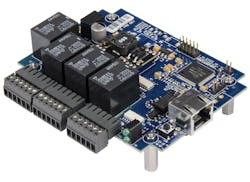Aside from motors and actuators, in the world of automation technology nearly everything exists in a box. Inside these boxes are the printed circuit boards (PCBs) that enable all the efficiencies and possibilities of modern manufacturing. Because these boards lie hidden inside boxes, we rarely think about them. But over the past decade, a significant revolution has occurred that has not only impacted system customization possibilities from an OEM point of view, but all the application possibilities you can imagine.
That revolution centers on the computer-on-module (COM) technology and COM Express in particular.
Essentially COMs are embedded computers that lack the connectors needed for attaching input/output peripherals directly. Therefore, a COM needs to be attached to a carrier board in order to connect to standard peripheral connectors. This separation of the COM from the carrier board brought about a huge change in the customizability of embedded computing systems in automation. It meant that boards could be more easily custom designed for industry- and application-specific purposes and that the computing power of the COM could be easily upgraded without having to change the supporting board structure.
Though COM technology has been around for several years, it was 10 years ago that the COM Express module was released by the PICMG (PCI Industrial Computer Manufacturers Group). COM Express is now considered the most widely used COM standard, which defines the physical size, interconnect, and thermal interface for a COM, according to ADLink, a supplier of industrial automation computing technologies.
In an article recently published by Military Embedded Systems, Charlotte Adams of GE Intelligent Platforms wrote: “COM modules were developed to insulate computer boards from processor churn. Before their invention, designers of single-board computers had to rethink their layouts each time their processors went out of production. Adopting a new integrated circuit required designers to develop supporting silicon, as well as low-level software and firmware. This setup typically entailed board redesigns with the accompanyingcostsand delays … The beauty of COM Express is that when a processor reaches end-of-life, it can be replaced with a new-generation, plug-in processor module without disturbing the underlying hardware.”
Speaking from a firsthand point of view, Earle Foster of Sealevel Systems—a supplier of industrial computers, networking and I/O technology—says that the open standard COM Express module has “changed our systems business.” He explained that, years ago, “COM modules used to have proprietary interfaces, but are now open,” enabling them to easily be adapted to diverse industries and applications.
Sealevel is well known for its rugged carrier boards which include common I/O features such as serial, analog and digital I/O, all of which can be designed to application-specific electrical and mechanical requirements and meet COM Express functionality requirements.
“OEMs like our boards because they can just change out the COM module to update the system in the field or for introducing new models,” says Foster. Echoing Adams’ point, he explained that, before the introduction of COM, carrier boards were “purpose built using multiple components” that had to be stacked on the carrier board. “Now we put all those features onto the PCB and the OEM only has to install the COM module needed for the application.”
While visiting Sealevel at its South Carolina headquarters, Foster showed me some of the company’s popular configurable carrier boards, including its new eI/O Ethernet and Power over Ethernet digital/analog I/O modules designed for use by OEMs.
“Our custom COM module carrier boards are used on everything from mining to automotive to medical OEM machinery,” Foster noted. “They allow OEMs to develop custom systems with minimal effort by combining an off-the-shelf COM with application-specific custom carrier boards.”
Today, Sealevel Systems, which builds its boards at its South Carolina headquarters, can be best characterized as “a low volume, high mix manufacturer” focusing on the customization requirements of its OEM customers, Foster says.
About the Author
David Greenfield, editor in chief
Editor in Chief

Leaders relevant to this article:
